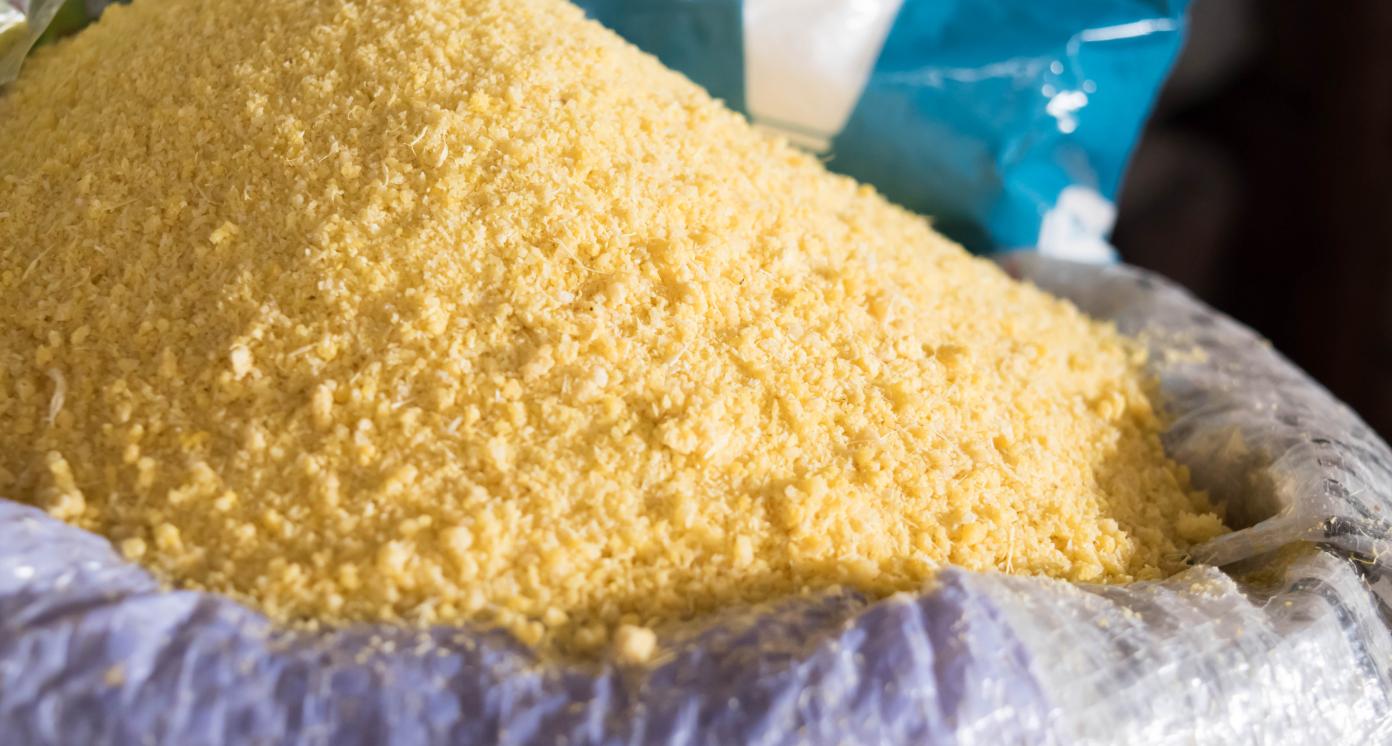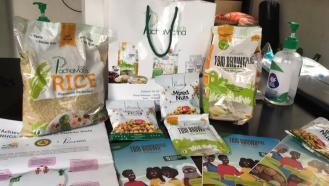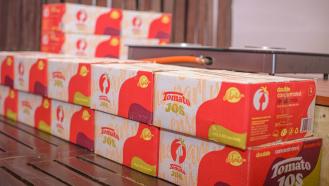Agro-industrial processing





Business Model Description
Establish agro-industrial processing facilities across the value chains in the Special Agro-Industrial Processing Zones (SAPZ).
Expected Impact
Increase value added in food chains, strengthen economic growth and generate decent jobs.
How is this information gathered?
Investment opportunities with potential to contribute to sustainable development are based on country-level SDG Investor Maps.
Disclaimer
UNDP, the Private Finance for the SDGs, and their affiliates (collectively “UNDP”) do not seek or solicit investment for programmes, projects, or opportunities described on this site (collectively “Programmes”) or any other Programmes, and nothing on this page should constitute a solicitation for investment. The actors listed on this site are not partners of UNDP, and their inclusion should not be construed as an endorsement or recommendation by UNDP for any relationship or investment.
The descriptions on this page are provided for informational purposes only. Only companies and enterprises that appear under the case study tab have been validated and vetted through UNDP programmes such as the Growth Stage Impact Ventures (GSIV), Business Call to Action (BCtA), or through other UN agencies. Even then, under no circumstances should their appearance on this website be construed as an endorsement for any relationship or investment. UNDP assumes no liability for investment losses directly or indirectly resulting from recommendations made, implied, or inferred by its research. Likewise, UNDP assumes no claim to investment gains directly or indirectly resulting from trading profits, investment management, or advisory fees obtained by following investment recommendations made, implied, or inferred by its research.
Investment involves risk, and all investments should be made with the supervision of a professional investment manager or advisor. The materials on the website are not an offer to sell or a solicitation of an offer to buy any investment, security, or commodity, nor shall any security be offered or sold to any person, in any jurisdiction in which such offer would be unlawful under the securities laws of such jurisdiction.
Case Studies
Country & Regions
- Nigeria: Countrywide
Sector Classification
Food and Beverage
Development need
About 25.5% of Nigeria’s population lacks adequate and improved nutrition.(1) Similarly, data from the National Bureau of Statistics suggests 26.4% of the population experienced severe food insecurity in 2016.(1) The Sustainable Development Report ranks Nigeria number 48.0 for SDG 2 (Zero Hunger). While performance against this Goal has improved, major challenges persist.(2)
Policy priority
The government intensified efforts to improve agricultural yield, and investments aim to improve agricultural infrastructure.(1) Policy priorities outlined in the Economic Recovery and Growth Plan aim to: increase agricultural GDP (gross domestic product) to NGN 21.0 trillion in 2020 at an average annual growth rate of 6.9%; reduce food imports; and become a key exporter of agricultural products.(3)
Gender inequalities and marginalization issues
Agriculture and trade account for the majority of Nigeria's employment opportunities. Most people in these sectors work informally (92% of those employed in agriculture, and 56% of those employed in trade), and so rely on daily wages. Generally, informal workers have no pension or life insurance, and have limited health insurance coverage. They are more exposed to shocks, especially to their health, and are vulnerable to poverty and hunger. Micro, small and medium enterprises (MSMEs) are most likely to be affected by the upcoming recession, and will take longer to overcome the economic impacts of COVID-19.(4)
Investment opportunities introduction
The government is also considering strategies such as providing irrigation infrastructure to enable year-round production to boost agricultural productivity.(3)
Key bottlenecks introduction
The Sustainable Development Report ranks Nigeria number 48.0 for SDG 2 (Zero Hunger). While performance against this Goal has improved, major challenges persist.(2)
Food and Agriculture
Development need
In 2018, agriculture accounted for 21.2% of Nigeria's GDP (gross domestic product) and employed two-thirds of the working population.(3) Indicators of adult obesity have improved, while indicators of undernourishment have underperformed. Prevalence of stunting in children is falling.(5)
Agricultural Products
Pipeline Opportunity
Agro-industrial processing
Establish agro-industrial processing facilities across the value chains in the Special Agro-Industrial Processing Zones (SAPZ).
Business Case
Market Size and Environment
Annually, Nigeria imports over USD 300 million worth of dairy products alone.
Africa's agro-allied economy is projected to reach USD 1 trillion by 2030.(6)
Nigeria's agricultural sector has seen some progress. Rice production increased from 3.8 million tonnes in 2017 to 4.8 million tons in 2019. Fertilizer production capacity also increased to over 2 million tonnes each year.(6)
Dairy demand in Nigeria was estimated at 1.7 million tonnes of milk, with local production satisfying only 5% of this demand. Nigeria imports over USD 300 million worth of dairy products annually.(7)
Indicative Return
> 25%
A benchmark company from Uganda (Mujaasi Investments Limited) aggregates, processes, markets and sells cereals, grains and fresh fruit. This fast-growing enterprise has a forecast internal rate of return of 233% over the 5 years following 2019.(8)
Investment Timeframe
Medium Term (5–10 years)
Producing cash flow from investments in agricultural processing depends largely on the specific sector. However, most agro-processors generate cashflow and profit in the medium term.
Ticket Size
USD 1 million - USD 10 million
Market Risks & Scale Obstacles
Capital - CapEx Intensive
Market - Highly Regulated
Capital - Limited Investor Interest
Impact Case
Sustainable Development Need
Nigeria is Africa's most populous country, with over 200 million people. The country has recorded impressive growth in infrastructure in recent years. However, existing infrastructure is not sufficient.
For the past four decades, agriculture has accounted for 30% - 40% of Nigeria's economic output and employed around 20 million people. The country has the available resources to feed itself, with 90 million hectares of arable land, abundant water supply and labour.(9)
Around USD 22 billion is spent annually on importing rice, sugar, wheat, maize and other food. This result reflects farming yields that are significantly lower than global averages. However, there has been some progress, e.g. rice production capacity increased from 3.8 million tonnes in 2017 to 4.8 million tonnes in 2019.(9)
Gender & Marginalisation
Long term efforts to improve women's access to agriculture and livelihood resources (including land, agricultural inputs and education) requires tackling cultural and gender norms that prevent women’s empowerment. Anecdotal evidence shows women are less likely to gain access to credit, land and other agricultural inputs.(17)
Expected Development Outcome
Investments could multiply benefits in terms of increased farmers' earnings, reduced farm losses, minimized distribution costs, and increased employment opportunities.
Investments could facilitate agro-allied clusters, transform rural communities and reduce poverty.
Gender & Marginalisation
Economic Recovery and Growth Plan (ERGP) 2020 target for female population that owned agriculture: 80.8%. SDG target by 2030: 100%.(18)
Primary SDGs addressed

1.1.1 Proportion of the population living below the international poverty line by sex, age, employment status and geographic location (urban/rural)
1.2.1 Proportion of population living below the national poverty line, by sex and age
1.2.2 Proportion of men, women and children of all ages living in poverty in all its dimensions according to national definitions
62.6% of Nigeria's population live below the international poverty line: 69% of people in rural areas live below the international poverty line, compared with 51% of people living in urban areas.(17)
46% in 2018.(19)
42.2% in 2017.(17)
The Federal Government is implementing a national Social Investment Programme which focuses on providing Social Safety Nets for the poor, welfare for the unemployed and job creation and skills enhancement with a target of creating about 3 million jobs.(17)
21.1% by 2030.(17)

2.1.1 Prevalence of undernourishment
2.1.2 Prevalence of moderate or severe food insecurity in the population, based on the Food Insecurity Experience Scale (FIES)
25.5% in 2015.(18)
Moderate: 26.4%. Severe 19.6%.(18)
Derived ERGP (Economic Recovery and Growth Plan) target by 2020: 17%, by 2030: 0. (18)
Derived ERGP (Economic Recovery and Growth Plan) target by 2020: 17.6%, by 2030: 0.(18)
Secondary SDGs addressed



Directly impacted stakeholders
People
Corporates
Indirectly impacted stakeholders
People
Outcome Risks
Investments could result in improper waste disposal from factories that causes environmental hazards.
Impact Risks
Alignment risk given production may not be locked into an enterprise model.
Efficiency risk given these models are usually scaled using concessional financing.
Stakeholder participation risk given land use issues may arise after agricultural production reaches large scale.
Impact Classification
What
Likely to have positive outcomes such as food security, employment opportunities, increased foreign exchange earnings, reduction in post-harvest losses, increased household incomes.
Who
Small and medium-scale farmers, processors, marketers, and all other players along the agricultural value chain.
Risk
Change in government legislature
Impact Thesis
Increase value added in food chains, strengthen economic growth and generate decent jobs.
Enabling Environment
Policy Environment
The Federal Government and key investors have endorsed the African Development Bank’s Special Agro-Industrial Processing Zones (SAPZ) initiative, describing it as a pathway to Africa’s agricultural revolution.(9)
SAPZs are designed to concentrate agro-processing activities within areas of high agricultural potential and comparative advantage to increase productivity and competitiveness.
Financial Environment
Financial incentives: A government subsidy is available for farm inputs such as food crop processing and storage equipment and facilities, irrigation structure, dam and borehole construction, pumps, sprayers and other farm machinery and equipment.(14)
Fiscal incentives: The agricultural production income tax exemption means companies carrying out agricultural production are exempt from income tax for 5 years. The exemption can be extended for an additional 3 years if performance is satisfactory.(13)
Nigeria's agriculture is to be transformed by integrating agriculture value chains with agricultural lending, facilitated by the Nigerian Incentive-Based Risk Sharing System for Agricultural Lending (NIRSAL).(13)
Regulatory Environment
Act No 19 of 1993 (as amended) and the Food and Related Products (Registration) Act No. 20 of 1999: The National Agency for Food and Drug Administration and Control (NAFDAC) is the regulatory body responsible for regulating and controlling food production, importation, exportation and sales.(10)
Food and Drug Act 2004: The legal environment around food, its handling and logistics is regulated by the Food and Drug Act Cap F32 Laws of the Federal Republic of Nigeria, which establishes provisions for ensuring food safety and regulates admissible ingredients.(11)
To enhance quality food production and supervise the sector performance, the Agricultural Transformation Implementation Council (ATIC) has been appointed to drive the Agricultural Transformation Agenda (ATA), which aims to increase efficiency and profitability along value added chains.(12)
The ATIC consists of the Agricultural Investment Transformation Implementation Group (AITEG), the Agricultural Value Chain Transformation Implementation Group (AVCTEG), the Ministry of Agriculture, the Agricultural Industry Advisory Group (AIAG) and the Agricultural Transformation Policy Group (ATPG). (13)
Other regulatory bodies include the Standard Organization of Nigeria (SON), Quarantine service, Federal Produce Inspection Service (FPIS), Presidential Initiative on Agriculture (PIA), Nigerian Incentive-Based Risk Sharing System for Agricultural Lending (NIRSAL)
Marketplace Participants
Private Sector
Deansmanger Project, Diageo Plc, Nigerian Breweries, United Africa Company (UAC), Flour Mills, Dangote Flour Mills Plc, OLAM, Honeywell Flour Mill Plc
Government
Agricultural Investment Transformation Implementation Group (AITEG), Agricultural Value Chain Transformation Implementation Group (AVCTEG), Ministry of Agriculture, Agricultural Industry Advisory Group (AIAG) and Agricultural Transformation Policy Group (ATPG), Nigerian Incentive-Based Risk Sharing System for Agricultural Lending (NIRSAL)
Multilaterals
International Finance Corporation (IFC), International organizations with focus on agriculture such as International Fund for Agricultural Development, Cultivating New Frontiers in Agriculture (CNFA)
Non-Profit
Local food banks, non-government organizations (NGOs), Cultivating New Frontiers in Agriculture (CNFA), Acumen Fund
Public-Private Partnership
Africa Agriculture and Trade Investment Fund (AATIF)
Target Locations
Nigeria: Countrywide
References
- (1) Federal Republic of Nigeria (2017). Implementation of the SDGs: a national voluntary review. https://sustainabledevelopment.un.org/content/documents/16029Nigeria.pdf
- (2) Sachs, J., Schmidt-Traub, G., Kroll, C., Lafortune, G., Fuller, G. (2019). Sustainable Development Report 2019. New York: Bertelsmann Stiftung and Sustainable Development Solutions Network (SDSN).
- (3) Federal Republic of Nigeria (2017). Economic Recovery and Growth Plan 2017 - 2020. Abuja: Ministry of Budget and National Planning.
- (4) Dalberg (2020). Charting the future for Africa's largest economy: Economic impact of COVID-19 in Nigeria. https://dalberg.com/wp-content/uploads/2020/04/FINAL_Dalberg-Report-Charting-the-Future-of-Africa%E2%80%99s-Largest-Economy.pdf
- (5) Federal Republic of Nigeria (2011). Agricultural Transformation Agenda 2011.
- (6) African Development Bank (2020). Nigeria: Investors say African Development Bank's Special Agro-Industrial Processing Zones will dirve agricultural revolution. https://www.afdb.org/fr/news-and-events/nigeria-investors-say-african-development-banks-special-agro-industrial-processing-zones-will-drive-agricultural-revolution-19246
- (7) Nigerian Institute of Animal Science (2020). Business models for scale-up entrepreneurship in the Nigerian livestock industry. https://nias.gov.ng/BUSINESS%20MODELS%20FOR%20SCALE-UP%20ENTREPRENEURSHIP%20IN%20THE%20NIGERIAN%20LIVESTOCK%20INDUSTRY.pdf
- (8) African Green Revolution Forum (2020). The Agribusiness Deal Room at the 2019 African Green Revolution Forum (AGRF). https://agrf.org/dealroom/wp-content/uploads/2020/07/Agribusiness-Deal_Room-AGRF-booklet_020919.pdf
- (9) African Development Bank (2020). Nigeria: Investors say African Development Bank's Special Agro-Industrial Processing Zones will dirve agricultural revolution. https://www.afdb.org/fr/news-and-events/nigeria-investors-say-african-development-banks-special-agro-industrial-processing-zones-will-drive-agricultural-revolution-19246
- (10) National Agency for Food and Drug Administration and Control (2017). About NAFDAC. https://www.nafdac.gov.ng/about-nafdac/nafdac-organisation/
- (11) Omojokun, J (2012). Regulation and Enforcement of Legislation on Food Safety in Nigeria. https://www.intechopen.com/books/mycotoxin-and-food-safety-in-developing-countries/regulation-and-enforcement-of-legislation-on-food-safety-in-nigeria
- (12) Innov8nigeria (2012). President GE Jonathan inaugurates the Agricultural Transformation Implementation Council (ATIC). https://innov8nigeria.wordpress.com/2012/05/14/president-ge-jonathan-inaugurates-the-agricultural-transformation-implementation-council-atic/
- (13) Federal Ministry of Agriculture and Rural Development (2012). Agricultural Transformation Agenda: We Will Grow Nigeria's Agricultural Sector. http://unaab.edu.ng/wp-content/uploads/2012/10/Agricultural%20Transformation%20Blue%20Print.pdf
- (14) Federal Ministry of Agricultural and Rural Development. Agricultural Policy for Nigeria. http://extwprlegs1.fao.org/docs/pdf/nig149296.pdf
- (15) 12) Innov8nigeria (2012). President GE Jonathan inaugurates the Agricultural Transformation Implementation Council (ATIC). https://innov8nigeria.wordpress.com/2012/05/14/president-ge-jonathan-inaugurates-the-agricultural-transformation-implementation-council-atic/
- (16) Asanita (2021). Utilization of cassava. https://www.asanita.com/
- (17) Federal Republic of Nigeria (2020). Integration of the SDGs into National Development Planning: A Second Voluntary National Review (2020). https://sustainabledevelopment.un.org/content/documents/26309VNR_2020_Nigeria_Report.pdf
- (18) Federal Republic of Nigeria (2017). Implementation of the SDGs: a national voluntary review. https://sustainabledevelopment.un.org/content/documents/16029Nigeria.pdf
- (19) UNDP (2020). Human Development Report (2020). https://www.ng.undp.org/content/nigeria/en/home/library/human_development/the-2020-human-development-report.html

















